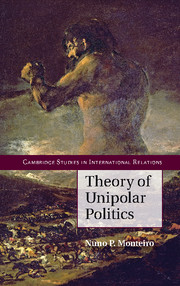Book contents
- Frontmatter
- Dedication
- Epigraph
- Contents
- Acknowledgments
- 1 Introduction
- 2 Conceptualizing Unipolarity
- 3 The Scope of Unipolar Strategic Choice
- 4 The Sources of Competition under Unipolarity
- 5 Competition in the Post–Cold War Era
- 6 The Sources of Conflict under Unipolarity
- 7 Conflict in the Post–Cold War Era
- 8 Conclusion
- Bibliography
- Index
2 - Conceptualizing Unipolarity
Published online by Cambridge University Press: 05 June 2014
- Frontmatter
- Dedication
- Epigraph
- Contents
- Acknowledgments
- 1 Introduction
- 2 Conceptualizing Unipolarity
- 3 The Scope of Unipolar Strategic Choice
- 4 The Sources of Competition under Unipolarity
- 5 Competition in the Post–Cold War Era
- 6 The Sources of Conflict under Unipolarity
- 7 Conflict in the Post–Cold War Era
- 8 Conclusion
- Bibliography
- Index
Summary
This chapter performs three functions. First, I lay out the basic IR theory underlying my arguments on unipolarity. I then provide definitions of concepts that are central to my theory. Finally, I conduct some groundwork on several important issues that underpin the arguments on unipolarity I make in the following chapters. Before I delve into these topics, I elaborate on the relationship between my theory of unipolar politics and the research tradition in which it is set: structural realism.
Structural Realism and Unipolarity
A theory of unipolarity is a theory of a particular configuration of the structure of the international system. Therefore, this book draws heavily on the long lineage of scholarship that falls under the label of structural realism. The most important work in the structural realist tradition is, without a doubt, Waltz's 1979 book Theory of International Politics. The central insight of this book is that the structure of the international system conditions the ways in which states’ goals lead to certain state behaviors that, in turn, produce particular outcomes. In other words, Waltz attempts to explain the most recurrent patterns in international politics – competition, conflict, alliances, and the like – by looking at the structure of the system rather than at its units, the states. By structure Waltz means the organizing principle of the system (anarchy or hierarchy), the functions of the units (whether states have similar or differentiated functions, particularly in what concerns their possession of military assets), and the distribution of power among them (how many great powers exist). In short, structural realism focuses on power and the structure of international politics.
- Type
- Chapter
- Information
- Theory of Unipolar Politics , pp. 28 - 62Publisher: Cambridge University PressPrint publication year: 2014



